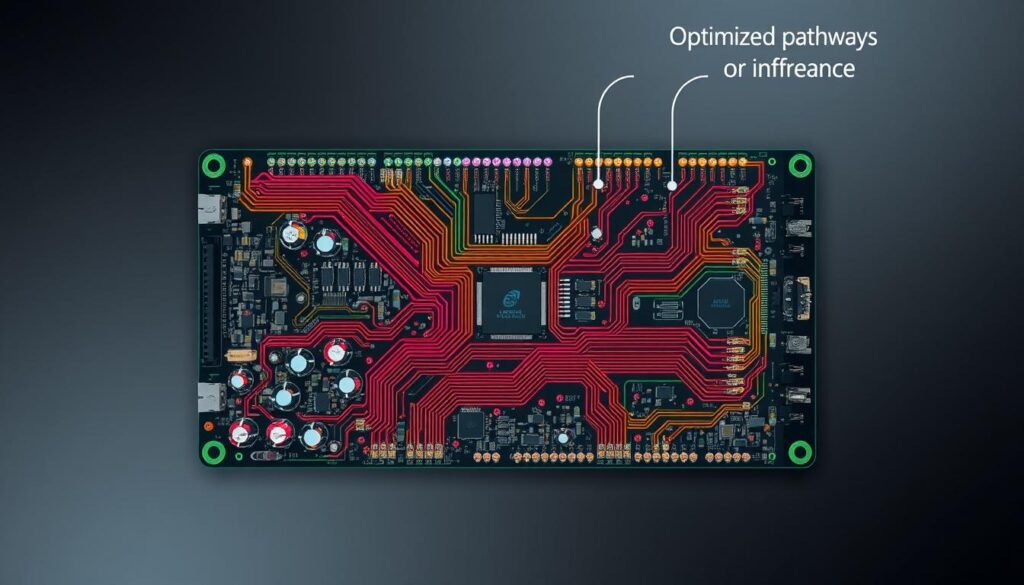In the world of plasma display technology, we often encounter a phenomenon known as the “antenna effect.” This challenging issue can significantly impact the performance and reliability of PD displays. It presents a critical concern for manufacturers and engineers.
As we delve into the understanding of this effect, we will explore its underlying causes. We will also look at the common scenarios in which it arises. Finally, we will discuss the measures we can take to mitigate its impact on circuit performance.
Table of Contents
Understanding the Basics of Antenna Effect
The antenna effect is a complex phenomenon. It happens when electromagnetic radiation meets charged particles in electrical circuits. This can greatly affect how well electronic devices work, especially in plasma display panels (PDPs).
Physical Properties of Antenna Effect
The core of the antenna effect is charge building up on conductive surfaces. This happens because of high-frequency electromagnetic radiation. It causes a current flow and charge buildup. The exact details depend on the circuit’s design and materials.
Common Scenarios Leading to Antenna Effect
- Exposure to strong electromagnetic fields during manufacturing processes, such as plasma etching or ion implantation.
- Inadequate shielding or grounding of circuit components, allowing external electromagnetic interference to couple into the circuit.
- Improper layout or routing of high-frequency signal traces, leading to the formation of unintended antenna-like structures.
Impact on Circuit Performance
The antenna effect can really hurt how well electronic circuits work. It can cause malfunctions, damage devices, and make them less reliable. For PDPs, it can lead to gate oxide breakdown. This can lower product yield and raise manufacturing costs.
| Effect | Impact |
|---|---|
| Charge Accumulation | Can lead to circuit malfunction and device degradation |
| Electromagnetic Radiation | Induces current flow and charge buildup on conductive surfaces |
| Gate Oxide Breakdown | Reduces product yield and increases manufacturing costs in PDPs |
Antenna Effect in PD: Causes and Mechanisms
In the world of plasma display technology, the antenna effect is a big deal. It’s all about how the physical parts of plasma display panels and charged particles interact. By looking into why it happens and how, we can better understand and solve this problem.
The main reason for the antenna effect is electrical charge buildup. As the display works, electrons gather on different parts, causing an imbalance. This imbalance can lead to high-voltage spots, causing unwanted discharges and problems with the display.
Electron accumulation also plays a big role. The complex shapes and conductive parts in the display can trap electrons. This makes the charge imbalance worse, affecting the display’s performance and reliability.
| Phenomenon | Description | Potential Impact |
|---|---|---|
| Charge Buildup | Uneven distribution of electrical charge within the display structure | High-voltage potentials, unwanted discharges, and disruption of normal operation |
| Electron Accumulation | Concentration of electrons in specific areas of the display | Localized electric fields and interference with display performance |
By understanding the causes and mechanisms of the antenna effect, we can find ways to fix it. Improving design and using new manufacturing methods are key. This will help keep plasma display technology reliable and working well.
Critical Impact on Semiconductor Manufacturing
The antenna effect is a big challenge in making semiconductors. It happens when electrical charges build up on metal parts during making. This can harm the quality and reliability of semiconductor devices.
Damage to Gate Oxide
The antenna effect is especially bad for the gate oxide. This part is key in semiconductors. The buildup of charges can stress it too much, causing it to break down. This breakdown can make devices fail.
Effect on Device Reliability
The antenna effect also hurts the long-term reliability of devices. It can cause problems like electromigration and hot carrier injection. These issues can shorten the life and performance of devices. Fixing these problems is key to keeping devices working well.
Production Yield Implications
Finally, the antenna effect can lower the yield in making semiconductors. When devices fail, it means more waste and lower production. This can make making semiconductors less profitable. So, it’s very important to reduce the antenna effect to keep production high and costs down.
| Impact | Description |
|---|---|
| Gate Oxide Damage | Excessive stress from charge accumulation can lead to gate oxide degradation, compromising device performance and reliability. |
| Device Reliability Issues | The antenna effect can induce various failure mechanisms, such as electromigration, hot carrier injection, and time-dependent dielectric breakdown, reducing device lifespan. |
| Production Yield Implications | Increased device failures due to the antenna effect can lead to higher scrap rates and lower overall production yields, impacting the cost-effectiveness of semiconductor manufacturing. |
![]()
Prevention Techniques and Design Strategies
The semiconductor industry is growing fast. This growth makes it more important to fight the antenna effect in circuit design. Engineers and researchers have come up with many ways to improve circuit performance and make devices reliable.
Circuit Design Optimization
One key way to fight the antenna effect is through better circuit design. This means thinking carefully about how the circuit is laid out and connected. It helps keep sensitive parts safe from high-energy plasma during making.
By designing circuits better, we can lower the antenna ratio. This reduces the chance of damage to the gate oxide or other problems.
Layout Techniques
Layout techniques are also helpful in fighting the antenna effect. Some strategies include:
- Keeping metal interconnects small
- Using multi-layer layouts to protect sensitive parts
- Adding shielding and grounding to lessen the antenna effect’s impact
Planning the circuit layout well helps avoid antenna effect problems. It makes the semiconductor device more reliable and better performing.
Antenna Effect Mitigation Strategies
To better prevent the antenna effect, a mix of techniques is used. These include:
- Improving circuit design to lower the antenna ratio
- Using advanced layout methods, like multi-layer designs and shielding
- Adding protection diodes and jumper strategies to protect sensitive parts
By using these detailed prevention techniques and design strategies, makers of semiconductors can fight the antenna effect well. This ensures they make reliable, high-quality devices.
| Technique | Description | Key Benefits |
|---|---|---|
| Circuit Design Optimization | Careful consideration of layout and interconnections to minimize exposure of sensitive components | Reduced antenna ratio, improved device reliability |
| Layout Techniques | Strategies such as minimizing metal interconnect area, utilizing multi-layer designs, and implementing shielding | Reduced exposure of sensitive components, enhanced mitigation of antenna effect |
| Combination of Techniques | Employing a comprehensive approach, including circuit design optimization, advanced layout, and protection diodes/jumper insertion | Holistic mitigation of the antenna effect, ensuring reliable and high-performing semiconductor devices |

Implementation of Protection Diodes and Jumper Insertion
Protecting sensitive electronic parts from the antenna effect is key in circuit design. To solve this, makers use protection diodes and jumper insertion.
Types of Protection Diodes
ESD and Clamping diodes are vital in stopping voltage spikes. They direct excess current away from important parts. This keeps them safe during making and use.
Optimal Placement Strategies
Finding the best spot for protection diodes is crucial. You need to think about signal paths, part density, and current flow. The right spot can greatly lower antenna effect failure risks.
Verification Methods
- Antenna Effect Verification: Special tests check if diodes and jumpers work against the antenna effect.
- Electrical Characterization: Tests like IV and CV ensure diodes protect as they should.
- Reliability Assessments: Tests under stress, like high heat and voltage, check long-term reliability.
By choosing, placing, and testing diodes well, makers can beat the antenna effect. This makes sure electronic devices are made reliably and with high quality.
| Diode Type | Function | Placement Considerations |
|---|---|---|
| ESD Diodes | Provide protection against electrostatic discharge events | Near sensitive components, along signal routes |
| Clamping Diodes | Limit voltage spikes and transients | At critical nodes, power/ground connections |
Best Practices for Manufacturing and Testing
Keeping quality high and following strict manufacturing rules are key to avoiding the antenna effect in semiconductors. A detailed approach to making and testing helps spot and fix problems early. This way, we can ensure the final product is top-notch.
Regular antenna effect testing is a must in the manufacturing process. It means using strict testing methods at every stage, from making the wafer to putting it together. This helps find and fix any antenna effect issues. By closely watching and analyzing data, we can find the main problems and solve them.
Also, it’s vital to follow manufacturing guidelines that tackle the antenna effect. These guidelines should cover important areas like:
- Proper handling and storage of wafers to avoid electrostatic discharge
- Optimizing plasma etching to lower the chance of oxide damage
- Using strong cleaning and passivation steps to protect sensitive parts
- Ensuring good grounding and shielding in the manufacturing area
By sticking to these guidelines, we can boost quality control and cut down on the antenna effect. This leads to more reliable and better-performing semiconductor devices.
In the end, a thorough approach to making and testing, with a solid grasp of the antenna effect and how to avoid it, is essential. It helps us create high-quality semiconductor products that meet today’s high electronics standards.
Future Developments in Antenna Effect Mitigation
The semiconductor industry is always looking to improve. We’re excited about new ways to reduce the antenna effect. Advanced nanomaterials and AI-driven design could make plasma display devices better and more reliable.
Researchers are exploring nanotechnology to solve the antenna effect. Nanomaterials could help create better shielding or designs that avoid the problem. This could lead to better device performance and allow for more advanced technology.
AI-driven design tools are also changing the game. They use machine learning to improve circuit layouts and protection. This could make designs safer, reduce problems, and increase the success rate of making semiconductors.

